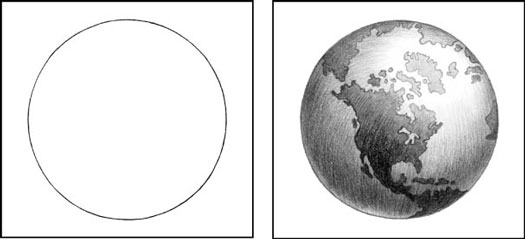What is shadow?
Adark figure or image cast on the ground or some surface by a body intercepting
Adark figure or image cast on the ground or some surface by a body intercepting
5 of 7 in Series: The Essentials of Drawing
Light and shadows visually define objects. Before you can draw the light and shadows you see, you need to train your eyes to see like an artist.
Values are the different shades of gray between white and black. Artists use values to translate the light and shadows they see into shading, thus creating the illusion of a third dimension.
Hatching and crosshatching are simple and fun techniques for drawing shading.
A full range of values is the basic ingredient for shading. When you can draw lots of different values, you can begin to add shading, and therefore depth, to your drawings.
With shading, the magical illusion of three-dimensional reality appears on your drawing paper. Figure 1 demonstrates hot to take a simple line drawing of a circle and add shading to transform it into the planet Earth.

Figure 1: Turning a simple line drawing into planet Earth.
You know the objects around you are three-dimensional because you can walk up to them, see them from all sides, and touch them. Take a moment to look around you at familiar objects. Try to discover why you see their actual three-dimensional forms. Look for the different values created by the light and shadows.
Taking a closer look at light and shadow
Before you can draw the appropriate values that illustrate light and shadows correctly, you need to be able to visually identify the following:
- Light source: The direction from which a dominant light originates. The placement of this light source affects every aspect of a drawing.
- Shadows: The areas on an object that receive little or no light.
- Cast shadow: The dark area on an adjacent surface where the light is blocked by the bject, which in this case is a sculpture. As you look at two drawings of the sculpture, ask yourself the following questions:
- Where are the light values? Look for the lightest areas on the object. The very brightest of the lightest values are called highlights.
- Where are the dark values? Dark values often reveal the sections of the object that are in shadow. By locating shadows, you can usually identify the light source.
- Where is the cast shadow? The section of the cast shadow closest to the object is usually the darkest value in a drawing. By locating an object's cast shadow, you can easily discover the direction from which the light source originates.

Figure 2: Looking for light and dark values and cast shadows.
The two drawings in Figure 2 have different light sources. Compare them and find the dominant light source in each.
If you guessed that the light is coming from the right in the first drawing, you would be correct. In the second drawing, the light originates from the left.
Each time you reposition the light source, identify the following:
- The shadows on the object (dark values)
- The brightest areas (the highlights)
- The light values (areas closer to the light source or not in shadow)
- The cast shadow (the darkest values)